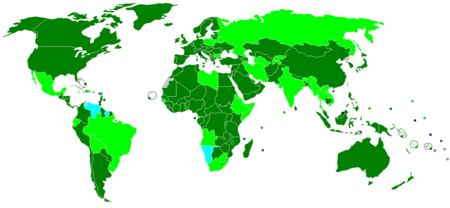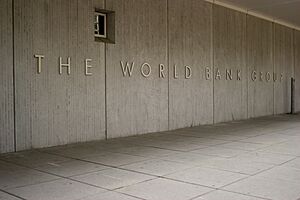World Bank Group facts for kids

The World Bank Group building (Washington, DC)
|
|
| Established | 4 July 1944 |
|---|---|
| Type | Intergovernmental organization |
| Legal status | Treaty |
| Purpose | Economic development, poverty elimination |
| Headquarters | 1818 H Street Northwest, Washington D.C., U.S. |
|
Membership
|
189 states (188 UN countries and Kosovo) |
| Ajay Banga | |
|
MD & CFO
|
Anshula Kant |
|
Main organ
|
Board of Directors |
|
Parent organization
|
|
The World Bank Group (WBG) is a group of five international organizations. They help developing countries by giving them loans and support. It is the biggest and most famous development bank in the world. The World Bank Group works to end extreme poverty and help people in all countries have a better life. Its main office is in Washington, D.C., in the United States.
In 2021, the group gave about $98.83 billion in loans and help to countries that are still developing. The World Bank Group includes five different organizations:
- the International Bank for Reconstruction and Development (IBRD)
- the International Development Association (IDA)
- the International Finance Corporation (IFC)
- the Multilateral Investment Guarantee Agency (MIGA)
- the International Centre for Settlement of Investment Disputes (ICSID)
Sometimes, when people say "World Bank," they are talking about just the IBRD and IDA together. These two focus on helping developing countries. They work on things like education, health, farming, and protecting the environment. They also help build roads and provide electricity. The IBRD and IDA offer loans at good rates. They also give grants (money that doesn't need to be paid back) to the poorest countries. This help often comes with ideas for how the country can improve its economy.
Contents
History of the World Bank Group
How the World Bank Group Started
The World Bank Group officially began on December 27, 1946. This happened after countries agreed to the Bretton Woods agreements. These agreements were made at a big meeting called the Bretton Woods Conference in July 1944. The World Bank started its work on June 25, 1946. Its first loan was for $250 million to France on May 9, 1947. This loan helped France rebuild after World War II. It was the largest loan the bank has ever given, when you consider how much money was worth back then.
Countries in the World Bank Group

Almost all 188 UN countries are members of the World Bank Group. Kosovo is also a member. All members are part of the IBRD. As of May 2016, all of them are also part of at least one of the other four organizations.
Here's how countries are members of the World Bank Group:
- Only in the IBRD: No countries are only in the IBRD anymore.
- The IBRD and one other organization: San Marino, Nauru, Tuvalu, Brunei.
- The IBRD and two other organizations: Antigua and Barbuda, Suriname, Venezuela, Namibia, Marshall Islands, Kiribati.
- The IBRD and three other organizations: India, Mexico, Brazil, South Africa, Thailand, and many others.
- All five World Bank Group organizations: Most of the 138 other members belong to all five.
Some countries and areas are not members. These include Andorra, Cuba, Liechtenstein, Monaco, Palestine, the Holy See (Vatican City), Taiwan, and North Korea.
The Republic of China joined the World Bank in 1945. After the Chinese Civil War, the government moved to Taiwan. It stayed a member until 1980. Then, the People's Republic of China took its place.
How the World Bank Group Works

The World Bank Group has its main office in Washington, D.C.. It is an international organization owned by the governments of its member countries. Even though it makes money, these profits are used to help reduce poverty around the world.
The World Bank is part of the United Nations system. However, its leadership is a bit different. Each organization in the World Bank Group is owned by its member governments. These governments buy shares, and their votes depend on how many shares they own. The president of the World Bank is chosen by the president of the United States. Then, the bank's Board of Governors votes to approve this choice.
The United States has a lot of voting power, about 16.4% of all votes. Japan has 7.9%, Germany 4.5%, and the United Kingdom and France each have 4.3%. To make big changes to the bank's rules, 85% of the votes are needed. This means the U.S. can stop any major changes. Because of its voting power and the president being nominated by the U.S., the U.S. has a lot of influence.
Organizations in the World Bank Group
The World Bank Group is made up of these five parts:
- The International Bank for Reconstruction and Development (IBRD): Started in 1944. It gives loans to governments.
- The International Finance Corporation (IFC): Started in 1956. It helps private businesses without needing government guarantees.
- The International Development Association (IDA): Started in 1960. It gives loans with no interest or grants to the poorest countries.
- The International Centre for Settlement of Investment Disputes (ICSID): Started in 1965. It helps governments reduce risks for investors.
- The Multilateral Investment Guarantee Agency (MIGA): Started in 1988. It offers insurance against certain risks, especially for private businesses.
The term "World Bank" usually means just the IBRD and IDA. The term "World Bank Group" or "WBG" refers to all five organizations together.
The World Bank Institute is a part of the World Bank. It helps member countries learn and build their skills.
The IBRD has 189 member governments. The other organizations have between 153 and 184 members. All World Bank Group organizations are led by a board of governors. This board meets once a year. Each member country chooses a governor, usually their finance minister. Every day, the World Bank Group is run by 25 executive directors. These directors are chosen by their governments or groups of countries.
The President of the World Bank Group
Traditionally, the president of the World Bank has been a U.S. citizen. They are chosen by the president of the United States. This is because the U.S. is the bank's largest shareholder. The chosen person then needs to be approved by the executive directors. They serve for five years and can be chosen again.
Current President
Ajay Banga is the current president of the World Bank Group. He is the 14th person to hold this job.
Managing Director
The managing director of the World Bank is in charge of how the organization works. This includes planning, technology, and security. The current managing director and chief financial officer is Anshula Kant. She started this role in October 2019.
Review of Mining and Oil Projects
For a long time, some groups were concerned about the World Bank's involvement in oil, gas, and mining projects. In 2001, the World Bank started an independent review called the Extractive Industries Review (EIR). This review looked into these projects.
The review was led by Emil Salim, who was a former Environment Minister of Indonesia. He talked to many different groups of people in 2002 and 2003. The final report came out in January 2004. It suggested that projects involving fossil fuels and mining did not help reduce poverty. It recommended that the World Bank stop supporting these projects by 2008. Instead, it suggested investing in renewable energy and clean energy.
The World Bank did not agree with all the report's ideas. However, the review did change how the World Bank handles oil, gas, and mining projects. For example, there was a discussion about the rights of indigenous peoples. Critics felt that the bank's response weakened a key idea. This idea was that indigenous peoples should agree to projects before they start. Instead, the bank decided there would be 'consultation' with them. After this review, the World Bank updated its policy on Indigenous Peoples.
List of Presidents
- Eugene Meyer (1946)
- John J. McCloy (1947–1949)
- Eugene R. Black, Sr. (1949–1962)
- George D. Woods (1963–1968)
- Robert McNamara (1968–1981)
- Alden W. Clausen (1981–1986)
- Barber Conable (1986–1991)
- Lewis T. Preston (1991–1995)
- Ernest Stern (Interim) (1995)
- James Wolfensohn (1995–2005)
- Paul Wolfowitz (2005–2007)
- Robert Zoellick (2007–2012)
- Jim Yong Kim (2012–2019)
- Kristalina Georgieva (Interim) (2019)
- David Malpass (2019–2023)
- Ajay Banga (2023–Present)
See also
 In Spanish: Grupo del Banco Mundial para niños
In Spanish: Grupo del Banco Mundial para niños
- Afghanistan and the World Bank
- Brazil and the World Bank
- China and the World Bank
- Honduras and the World Bank
- Zimbabwe and the World Bank
- Architecture of Washington, D.C.


